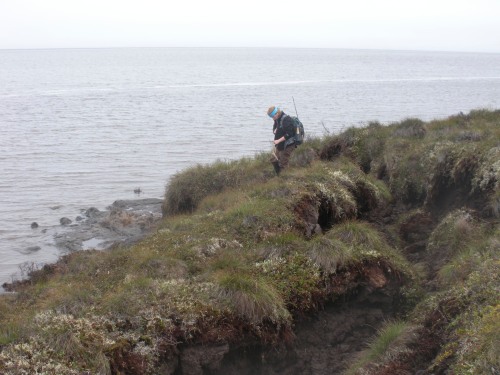Each night when I walk home or to the school, I breath in the icy breeze of the Ninglick River and smell that signature campfire scent from the steam baths* being prepared all over the village.
Sometimes I stand on the front porch of the school or at the house and look out at the rippling river and at the tundra, its tall grasses waving and reflecting light just like the water, and as I gaze at the village I feel a sense of comfort and sentimentality in knowing that this place is pretty much my whole world right now.
But as difficult as it might be to conceive and accept, this little piece of the world will disappear in just a few years. It’ll exist only as pieces of land and remnants of buildings resting silently under the surface of the salty sea.
At the shocking rate of sixty feet per year, the water inches closer to the village each day. Erosion and (do I dare say it?) global warming causing the permafrost to melt are reasons behind why the land is falling off into the river in massive chunks. I’ve never seen anything like it before, but it’s quite obvious to anyone living here that the village of Newtok is literally sinking.
One of the many downsides to this is that the natives don’t respect the environment in and on the outskirts of the village as much as they normally would. Because everything will be submerged in a matter of years and will be left behind in the big move, most people don’t care if there is trash lying around or if there are horribly broken boardwalks or if they dump their honey buckets* in the wrong places. Because they know they’ll soon never see this place again, keeping it clean is viewed as a waste of time.

A couple weeks ago, a neighbor and teacher friend of ours named Heidi, a gusuq* who’s married to a Native, mentioned her husband’s childhood memories of when the river wasn’t even visible from his home. So just about twenty years ago, I’d be looking out my kitchen window to the grassy tundra instead of to the river. The other day some teachers joked about hosting cross-country meets in Newtok before the water comes: “If we wait too long, we’ll have to pass out floaties to everyone as they get off the plane.” Although that would be an adventure, the village (all the people and as many homes that can be moved) will be transplanted to a spot on Nelson Island called Mertarvik, which is the promised land of rural Alaska compared to Newtok now. Kim will be here to witness and help in that slow and difficult process, but I’ll only be here long enough to soak in the end times of this piece of earth before it’s swept out to sea.
Last week a group of gusuqs came in from Anchorage to hold community meetings about “the move,” as everyone refers to it. There are booklets in the common areas at the school including honey bucket and water supply information for the new site, and there are posters on the walls with overall layouts of the moving plan. The Anchorage group met with some Newtok students and took notes on what the students would like to see in their new village, some of which included a Wal-Mart and a coffee shop. :). Mertarvik is already being prepared for everyone to make the move. So just like Laura Ingalls Wilder and hundreds of other pioneers hopped into their Conestoga wagons and found their way onto new pieces of land years ago, today in Alaska natives and teachers alike will soon hop into boats with all of their belongings and voyage across the river to a new piece of land they’ll call home.
___________________________________________________________________________
*Steam baths- the Yupiks use this traditional way of bathing instead of a normal shower or bath. Because of the lack of a plumbing system and plentiful clean water, they’ve discovered the best way to keep decent hygiene is to light wood or charcoal right in a room of the tiny building and bathe in the steam that collects in another room. It’s like a tiny yet very powerful sauna.
*Gusuq – the Yupik name for white people. There’s no demeaning undertone to it; it’s just a title that the Eskimos have for us, and in turn, we call ourselves gusuq as well. There are 9 gusuq in the village right now.
*Honey buckets – Since there’s no real plumbing around here except for at the school, the homes either use electric incinolets or old fashioned bedpan type receptacles. The sewage is supposed to be dumped in a specific place to keep it away from the natural water sources and the ground that we could walk on, but because of the unhealthy habit of dumping them in the wrong places, some areas of the village are infested with E-Coli.









